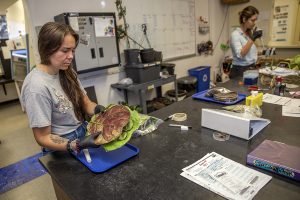“I always wanted to be a scientist. I always wanted to be a biologist – I wanted to be a marine biologist” said Dr. Romina Gazis, Associate Professor of Plant Pathology at the UF/IFAS Tropical Research and Education Center (TREC) in Homestead. Gazis was working toward that goal at Ricardo Palma University in Lima, Peru when a problem with her inner ear forced her to reassess her plans. “The doctor told me I could not scuba dive,” Gazis said. “I knew that if I couldn’t experience firsthand the systems that I work with, I was going to get frustrated in the future.” Gazis was visiting a forest near the Amazon for an undergraduate mycology class when she had a revelation. “I realized that the diversity of fungi on the forest floor is really very similar to a coral reef,” Gazis said. “I decided [mycology] was my calling.”
Tropical Research and Education Center Plant Diagnostic Clinic 
Gazis, who has a doctorate in Plant Science from the University of Maryland and a master’s in Environmental Science from Texas Christian University, directs the Plant Diagnostic Clinic at TREC. The clinic is one of six UF/IFAS laboratories across the state tasked with the diagnosis of commercial, homeowner, and extension plant disease samples. The clinic at TREC deals primarily with ornamental plants and tropical fruits. “We provide diagnostic services and recommendations,” Gazis said. “We diagnose the problem, and we also follow up and provide recommendations on how to solve the problem.”
The clinic diagnoses 1,300 samples a year, mostly tropical ornamental plants in containers. In Miami-Dade County alone, there are 1,600 nurseries, mostly growing tropical ornamental plants, Gazis said. “People up north buy plants for their offices – they’re usually tropical foliage, and those plants are produced here.”
Commercial producers, landscapers and pest control companies are the clinic’s primary clientele. Demand is high, but capacity is lower than Gazis would like it to be. “We’re a reactive service,” Gazis said. “People come to us when they have a plant that is already showing issues. We tell them the problem, and we give them recommendations.” Gazis would prefer to have a more proactive approach. “For instance, a landscaper is going to install a bed of plants. Wouldn’t it be great to test the soil…to know if there are soil-borne pathogens before putting the plants in the ground?”
 Laurel Wilt of Avocados
Laurel Wilt of Avocados
While Gazis is responsible for all tropical ornamental plants and fruit crops, her primary research focus involves avocados.
Avocados can suffer from many diseases, but much of Gazis’ research involves laurel wilt, a vascular disease caused by the fungus Harringtonia lauricola. “Florida’s avocado industry includes approximately 4,200 acres in Miami-Dade County, representing a $54 million impact on the economy. Laurel wilt was first discovered in South Florida in 2012, and it “has hit the Florida avocado industry, and is a threat to the avocado industry worldwide,” Gazis said.
“We’re looking into different management strategies,” Gazis said, which includes early detection. “That’s where the clinic plays a role. We design new protocols and come up with new strategies on how to detect the pathogen early on, and how to build surveillance programs to monitor the pathogen.” Those strategies should prove useful in areas where the pathogen isn’t present yet, she said. “California, Mexico, Central America – any other avocado-producing region can use these protocols to detect the pathogen early on.
Social Media 
Gazis maintains a popular account on X, the social media platform formerly known as Twitter. Created in spring 2020, the account was a way to stay connected while most of the world shut down because of the COVID-19 pandemic. “I was recently hired,” Gazis said, “then the pandemic hit. How do you keep connected to your network of collaborators and potential collaborators?”
“I wanted to spread the word about laurel wilt,” Gazis said. “I wanted to reach other states and other countries [that grow avocados].” Her followers were initially people she knew personally. “Little by little, I started to gain an audience.” She now has about 6,500 followers: “I communicate with entomologists, with horticulturists; not just plant pathologists. And that’s the purpose – to reach audiences that I wouldn’t reach otherwise.”
Looking to the Future
Gazis would like to see a bigger investment in diagnostics and training for people in the plant industry. “These are the people who will see the problems first,” she said. “As faculty members, we are not in the field 24/7. But these people – producers, landscapers, pest control companies – these are the people that are in the field, because that’s where their work is,” Gazis said. “And so having a hub here in South Florida that not only provides access to diagnostic services and information, but also provides training to them” so they can provide the first line of defense against invasive pest diseases would be a great investment, Gazis said. “I think it’s a good investment. It will pay off. Definitely.”
###
 6
6
